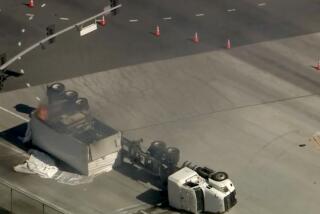Freeway Tragedy Is No Surprise, Experts Say
The only surprising aspect of the truck crash that killed six people this week on the Long Beach Freeway is that the tragedy did not occur years ago, veterans of the outmoded highway say.
They called the accident a perfect storm of safety problems: too many trucks, a 1950s freeway, a notorious intersection and lanes jammed with morning traffic. The Thursday collision followed two other truck accidents in less than three months that killed two other people on a freeway choked with ever-increasing truck traffic from the ports of Los Angeles and Long Beach.
The Thursday crash occurred at 8:25 a.m., bringing new questions about why the ports had not changed their hours long ago to reduce the number of trucks traveling during peak commuter hours. Port terminal gates are generally open during the day, flooding the freeway with trucks while commuters are traveling to and from work.
Port officials have long said that altering the hours at the ports would mean revamping the way many shippers and suppliers do business. Even if the ports modified their hours, they say, there is no guarantee other businesses would do the same.
Such comments do not satisfy critics.
“This stupid and risky system that they have right now is totally the fault of a lack of leadership on the part of the ports,” said Rep. Dana Rohrabacher (R-Huntington Beach), who has pushed the ports to extend gate hours. “I’m very sad to hear that some innocent people had to pay for this incompetence with their lives.”
Los Angeles Councilwoman Janice Hahn is also lobbying for extended gate hours, saying it must be done to move cargo safely along commuter highways.
“The infrastructure is failing. The volume of cargo is tripling by 2025,” said Hahn, who, like Rohrabacher, represents the port area.
Others said the accident emphasizes how booming freight movement through the Los Angeles area is putting lives at risk.
“I’m more scared than angered,” said an East Los Angeles community organizer, Angelo Logan, who has lobbied to curb port-related traffic. “The comments we hear from the industry side is that accidents rarely happen. In the past few weeks, we’ve seen that accidents do happen, and they happen close to home.”
Thursday’s accident occurred on the Long Beach Freeway north of the Santa Ana Freeway, an intersection long considered dangerous by transit planners and the California Highway Patrol.
A northbound tractor-trailer hit a compact car and tore through the center divider at Olympic Boulevard, crushing another car.
The Los Angeles County coroner’s office on Friday released the names of five people who were killed. James Hernandez, 48; Jeffrey Davis, 41; Clifton Crymes, 36; and James Glasper, 39, were riding in the truck.
The driver of the second car was identified as Jorge Manzur, 50, of Glendale. The name of his passenger, a woman who died at a local hospital, was not released.
The men in the tractor-trailer were employees of Rebel Van Lines, a family-owned firm in Compton. The truck was carrying furniture, clothes and toys belonging to a family moving from Hawaii to California. The shipment came in through the Port of Los Angeles and was transferred Thursday morning into the Rebel Van Lines truck.
Highway Patrol officers said preliminary investigations had confirmed that the accident had occurred after the compact car collided with the truck, probably during a lane change, but they said it was not yet clear which driver was at fault.
Some planners and commuters believe the condition of the freeway contributed to the crash. They pointed to the condition of the roadway, designed in the 1950s largely for cars but now carrying 15% of the nation’s international cargo. About 47,000 trucks travel the 24-mile freeway each day, a number expected to double or triple in coming years.
An ambitious plan to rebuild 18 miles of the freeway faltered this spring when residents complained that they had been left in the dark about a project that could remove 800 or more homes in poor neighborhoods. A lack of federal and state funds means that any plan is unlikely to proceed soon, officials say.
“The bottom line is that we need to improve the corridor physically by expanding the freeway, by upgrading the freeway to state standards, and also adding truck-only lanes,” said Stephen Finnegan, transportation policy manager of the Automobile Club of Southern California. “The physical improvements need to happen.”
The truck crashed into a metal-and-wood barrier on the freeway median. Such barriers on the Long Beach Freeway were to be replaced with concrete barriers as part of a $400-million improvement, but a Caltrans spokeswoman wrote in an e-mail Friday afternoon, “There is no funding at this time to install the concrete barriers” on the Long Beach Freeway from the San Diego Freeway to the San Bernardino Freeway.
Concrete barriers are generally better able to withstand the weight of trucks than metal-and-wood barriers. At the Texas Transportation Institute, safety engineers said Friday that although metal-and-wood barriers are more flexible, and thus cushion the impacts of cars, concrete barriers that are at least 32 inches high are best suited for areas with narrow medians.
Caltrans officials did not respond Friday to questions about the status of a lawsuit brought against the state by the family of a man who was killed in November 2001 when a big rig crashed through a barrier on the Long Beach Freeway near Firestone Boulevard. The suit alleged that the wood-and-metal barrier was too weak to stop trucks from crossing into oncoming traffic.
Caltrans officials also did not respond to questions about the width of freeway shoulders where the accident occurred. The most frequent question being raised by critics is why so many trucks must coexist with commuters during rush hours.
Highway Patrol statistics show that most truck-related collisions on the Long Beach Freeway occur on weekdays between 8 a.m. and 4 p.m.
For instance, a total of 1,042 collisions occurred on Thursdays in 1992-2000, compared with 212 on Sundays; 1,882 collisions took place between 8 a.m. and noon, compared with 152 between midnight and 4 a.m., and 257 between 8 p.m. and midnight.
Those numbers show why it would make sense to spread truck trips into evenings, nights and weekends, according to those trying to get port terminals to stay open during off-peak commuting hours.
Coincidentally, the Port of Los Angeles on Wednesday, a day before the crash, created a new working group that will study how to move more truck traffic to non-peak hours throughout freeway system.
But at the California Trucking Assn. in Sacramento, Chief Executive Joel Anderson said he had spent more than 20 years trying to get extended gate hours at the Los Angeles-Long Beach port complex, now the largest in the nation.
“We’ve been told that, because of their work rules and their conditions, they can’t put on second shifts and third shifts,” Anderson said. What trucking companies need is a wholehearted commitment by the ports and its shipping companies to keep gates open longer, he said.
“My guys will go if they know they can make a buck. If they had to be at the port at 8 p.m. for delivery at midnight, our truckers will be there,” he said.
Representatives of both ports say that extending gate hours requires the commitment of not just the ports, but of warehouses and shippers.
“We can’t compel them to do this. We’re lobbying them to do it,” said Art Wong, a spokesman for the Port of Long Beach.
At the Los Angeles port, spokeswoman Theresa Adams-Lopez said: “If there aren’t enough truck drivers willing to work in the middle of the night, if there are not enough warehouses open to accept the cargo, then leaving the gates open doesn’t really accomplish anything.... All the businesses all along the supply chain need to be committed to it and work toward it.”
Hahn and Rohrabacher said they were losing patience with such reasoning. In a June letter to Los Angeles harbor commissioners, Hahn wrote: “Following the examples of the ports of Hong Kong and Singapore, which operate 24 hours a day, seven days a week, it seems apparent that now is the time to focus our attention toward operating the Port of Los Angeles as a 24-hour, seven-day-a-week facility -- significantly diverting truck traffic to off-peak hours.”
Rohrabacher is even more blunt. “This is not the fault of the warehouses. This is the fault of the people who run the ports,” he said Friday.
Rohrabacher said he had told the ports he would willingly sit down with the warehouse owners, truckers, shippers and union representatives to try to help work out a new system.
He added, “They’ve never called on me yet.”
*
Times staff writer Allison Hoffman contributed to this report.
More to Read
Sign up for Essential California
The most important California stories and recommendations in your inbox every morning.
You may occasionally receive promotional content from the Los Angeles Times.








